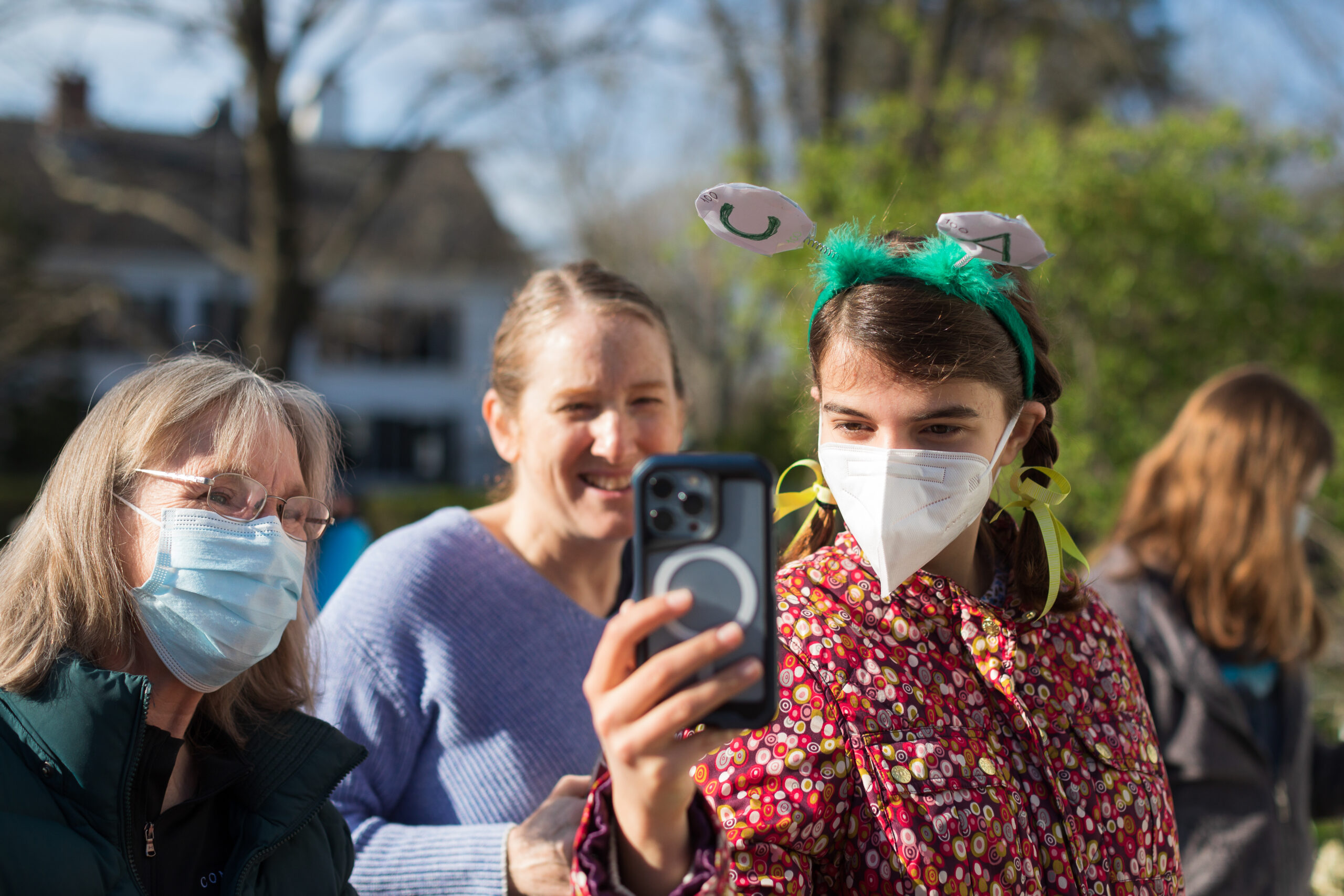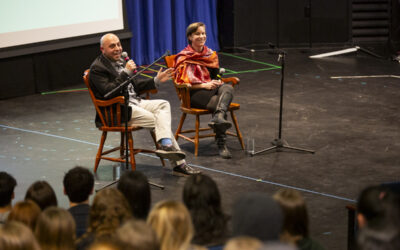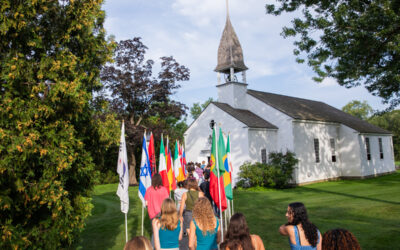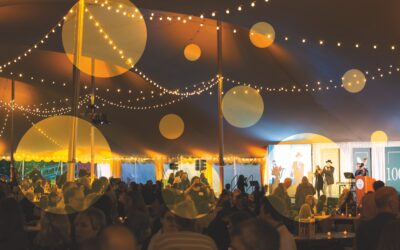
CA classes bring local history to life through augmented reality
If you hold your phone up to the Chapel, you can see artifacts from its history and construction that appear to be floating in front of it.
In a video, a student discusses Concord Academy’s search for seating to meet 1950s fire regulations (suitable pews eventually arrived, along with an old meetinghouse from New Hampshire, which became the Elizabeth B. Hall Chapel). Turn to the east, and you’ll see photos showing stages of the reconstruction, hovering before the arborvitae. Turn west, and you’ll encounter a scale model of the steeple. Walk around the model and you can see from all angles the bell, on its side, ready to be installed.
Navigating with phone in hand is familiar by now for most of us, but moving through locations both onscreen and in three dimensions still feels decidedly new. Today, CA’s campus is dotted with dozens of virtual points visible through Hoverlay, an augmented reality (AR) app. Each marks a stop on one of three Centennial AR history tours students developed last year, guided by history teacher Kim Frederick and computer science teacher Ben Stumpf ’88. The tours tell the stories of the people—Nipmuc, Wampanoag, English, African, and American—who inhabited the land upon which Concord Academy sits, before and after the school’s establishment.
In Frederick’s fall 2021 U.S. public history research seminar, students investigated CA’s institutional history and the 19th-century history of its buildings. They also explored much earlier eras. “I asked them to go all the way back to geologic time,” Frederick says. Indeed, the pre-19th-century tour starts with the formation of an ice sheet in the area.
Frederick’s students are no strangers to hands-on learning. Over many years, she and her colleagues in the History Department have developed partnerships with the Concord Museum and the Concord Free Public Library, which give students unique opportunities to “do history,” she says, such as by conducting original archival research and getting special access to artifacts. And one learning experience leads to the next.
A few years ago, Frederick read about “memory holes”: circular, foot-deep hollows that Indigenous people had dug before Europeans arrived throughout what later became southern New England. The holes marked locations where something remarkable had happened, physical aids to oral history. That concept made her think about presenting place-based history in a new way.
Frederick says there’s been “a huge shift” in the discipline over the past 20 years. “We’ve blasted open the idea of a master narrative,” she says. “Now we’re looking at women’s history, Native American history, LGBTQ+ history, Black history—and that’s all great. But we’re facing this dilemma of how we can tell all of our history together.”
Concerned about how exclusive focus through these lenses of social identity can fragment historical understanding, Frederick sees great potential in physical space as an organizing principle. “Can putting all these layers together help us understand history in a way that emphasizes our common humanity?” she asks. “That was one of the visions behind this project.”


John Oh ’23 had learned about memory holes from Frederick in a previous class, and he had also made a demo app, a precursor to the AR tours. So it was fitting that last year he took both Frederick’s class and Stumpf’s. “I was excited to do the very research that I would be presenting and interacting with in Ben’s class,” he says. “Participating in the entire process from start to finish was an extremely attractive opportunity to combine my interdisciplinary interests.”
He calls Frederick “a teacher who gives a lot of agency to her students and is very flexible with her plans.” That was particularly important, he says, “considering how much our project changed throughout just one semester.” In the end, researching and creating the tours made him feel closer to CA. “It was also just really fun,” he says, “because the impacts of the history are directly observable even right now.”
The idea for a history-tech CA collaboration wasn’t new. In 2018, Frederick and film teacher Justin Bull P’25 co-taught a course in partnership with the Robbins House, a local museum of African American history. At just 500 square feet, the museum couldn’t accommodate both furniture and guests. The teachers hoped to offer visitors a “more human” encounter through some sort of digital overlay that would give a sense of how the home had been furnished, Frederick says, but “at the time the technology didn’t exist.” So when, a couple of years later, she caught wind of an AR app that would work on any phone or tablet, she lost no time in finding a partner to use it at CA.
Stumpf admits he didn’t initially see the appeal of AR. “I thought it was gimmicky at first,” he says. But he likes to understand how technology affects people, and after some experimentation he realized that something different was happening to him as he accessed text, images, video, and models in particular locations. The layers of interpretation gave him what he calls “a new level of historical empathy.”
Soon his spring 2022 class Mobile Apps for History was bringing to life the three tour scripts Frederick’s students had developed. Stumpf’s class divided into several teams—for green screen filming, which creates videos without backgrounds; museum asset management; project management; and testing. They benefited from the guidance of Hoverlay’s founder, a Concord resident, and of Jon Amakawa, who specializes in developing AR mobile apps for historical landmarks and the National Park Service.
One remarkable experience the museum group had was taking high-definition photographs of the Concord Museum’s collection of 5,000-year-old arrowheads, which are arranged in chronological order in the form of a turtle. “We gave the image back to the museum and they’ll be able to use it for years,” Stumpf says. “Everything we make we give back— it’s a symbiotic relationship.”
Those external connections, says Jessie Ma ’24, “emphasized that this project was bigger than just a one-semester class, and that many people came together to combine history with technology that is relatively new.” She credits Stumpf with trusting her and her classmates to take initiative, supporting them with information but also “pushing students to make artistic decisions and learn to problem-solve.”
Jessie’s role was to coordinate all the points in the app. “I learned a lot about coordinating with the other groups, work flow, and going between platforms,” she says. “I was able to get a taste of what it would be like working on a tech team, and it taught me how a team could work to everyone’s strengths.”
Archie Daffner ’23 worked on the Google Map tour, his first web development project. “I had to learn JavaScript, HTML, and CSS, but once I got over the hurdle, I got to expand my skills,” he says. Like John, he took both classes, and he appreciated how Stumpf’s visits in the first semester helped guide the historical research. “It’s more interesting to walk around the area now,” he says.
“This project was wildly—overly— ambitious,” Frederick says. Stumpf grins and counters, “It was Kim-bitious.” The two have coached Ultimate Frisbee at CA together for years, and they say the strength of their relationship made the partnership immensely fun.
Stumpf says CA’s tours will continue to grow and evolve. And he expects AR to take off in general. “We’ll be seeing a lot of augmented reality emerging over the next several years,” he says. “It’s going to be really big.”
Frederick already has plans to share more of Concord’s history using the technology. She serves on the subcommittee on history and education for the committee planning the Town of Concord’s commemoration of the Battle of Concord’s 250th anniversary in 2025. She has proposed using Hoverlay, and conversations are now underway about adopting AR for anniversary installations. Imagine hearing British officers’ woods at the Old Hill Burying Ground, in the very place they stood while planning an attack— soon it will be possible, thanks to augmented reality.
By Heidi Koelz
Photos by Nicholas Pfosi and Cole Stipovich


